To clean a dirty bird feeder, first, empty it of any leftover food. Then, soak the feeder in a solution of one part bleach to nine parts water for about 10 minutes. Scrub the feeder with a long-handled brush to remove dirt and bird droppings. Rinse thoroughly to ensure no bleach residue remains, and let it dry completely before refilling. It’s best to clean bird feeders every two weeks, or more frequently during periods of heavy use or wet weather, to prevent the spread of diseases.
Key Takeaways on How to Clean Your Bird Feeder
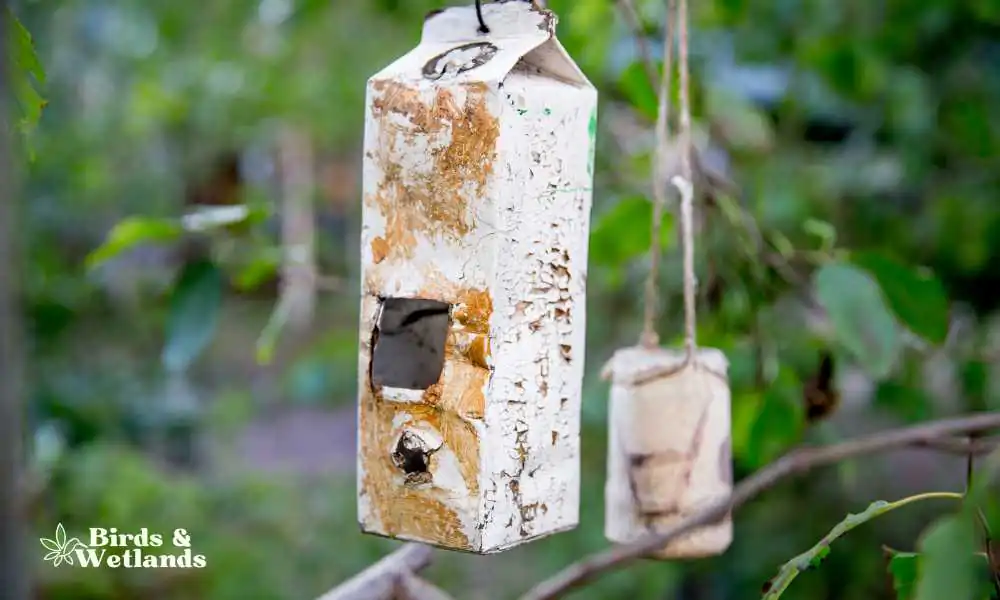
How to clean bird feeders safely
Here’s a step-by-step guide on how to do it:
Materials:
- Warm water
- Mild dish soap
- Scrub brush or old toothbrush
- Bleach or vinegar (optional)
- Rubber gloves
Steps:
Empty the Feeder
Remove any remaining seeds or debris from the feeder.
Preliminary Rinse
Rinse the feeder with warm water to get rid of loose debris.
Soak and Scrub
Fill a basin with warm water and a small amount of dish soap. Soak the feeder in this mixture for a few minutes, then scrub it thoroughly using a scrub brush or an old toothbrush. Pay special attention to corners and crevices where old seeds or mold might be stuck.
Rinse Again
Rinse the feeder well with warm water to make sure all soap residue is removed.
Disinfect (Optional)
If your feeder was particularly dirty, or if you know there has been a disease outbreak in your local bird population, you may wish to disinfect the feeder. You can do this by soaking it in a solution of 1 part bleach to 9 parts water, or 1 part white vinegar to 4 parts water. After soaking for a few minutes, rinse it thoroughly again with warm water.
Dry
Allow the feeder to air dry completely before refilling it with bird seed. This helps prevent mold and mildew.
Why do you need to clean feeders regularly?
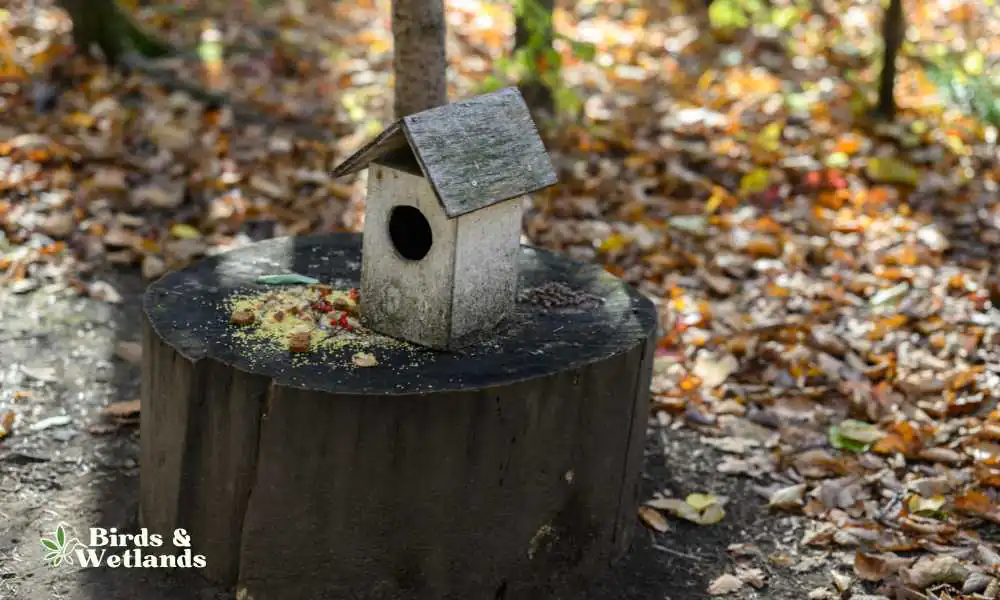
Keeping bird feeders clean is incredibly important for the health and well-being of our feathered friends. Dirty feeders can harbor harmful bacteria and fungi that can lead to the spread of infectious bird diseases such as avian pox and those caused by salmonella bacteria, making birds sick and even causing death in some cases.
Dirty bird feeders with leftover seed and rotten fruit can also attract insects, unwanted pests, such as rodents and other wild animals, spreading disease and damaging the feeder itself.
Regular cleaning of bird feeders is essential to prevent harmful bacteria and fungi buildup. Bird feeders should be regularly emptied and scrubbed with warm, soapy water and mild soap and allowed to air-dry before refilling with fresh seed. It is also important to regularly remove any uneaten seeds and debris from the area around the feeder to prevent the accumulation of harmful bacteria and pests.
Keeping feeders and bird baths clean can also help to attract more birds to your backyard. Birds are more likely to visit and use clean feeders and will be less hesitant to return if they feel safe and healthy in their feeding areas. Regular cleaning of bird feeders is a simple yet crucial step in creating a safe and welcoming habitat for our avian neighbors.
How often should you do bird feeder cleaning?

Bird feeders are a great way to attract birds to your backyard, but it’s important to keep them clean in order to avoid the spread of disease and maintain the health of your feathered friends. The frequency with which you should clean your bird feeders depends on a variety of factors, including the type of feeder, the weather conditions, and the number of birds visiting the feeder.
As a general rule of thumb, it’s recommended to clean your bird feeder at least once every two weeks or more often if it’s heavily used or if there are reports of sick birds being spotted in your area. If you notice any signs of mold, mildew, or other buildups, it’s important to clean your feeder immediately to prevent the spread of disease.
How often one should clean feeders depend on the type of food inside the feeder. For instance, a hummingbird feeder filled with sugar solution is susceptible to mold and bacteria growth, so it is extremely important to replace sugar water and clean feeders daily.
How to clean bird feeders
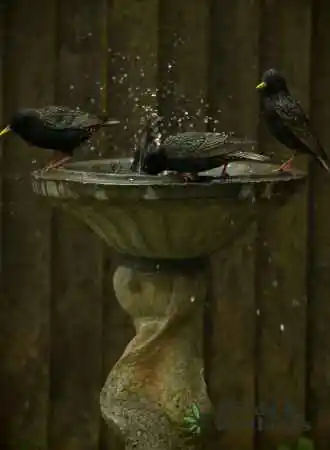
Feeding birds can be a rewarding experience. But it comes with the important responsibility of maintaining feeders clean. Cleaning bird feeders is important to create a safe feeding area for backyard birds. Here’s how to get started:
- The first step is to empty the feeder of any remaining sugar water if cleaning hummingbird feeders or remaining seed or suet if cleaning bird seed and suet feeders. Dispose of any uneaten bird food properly. You can use this opportunity to examine the feeder for any signs of mold or other contaminants.
- Take apart the feeder and separate all the components. Depending on the type of feeder you have, you may need to unscrew some parts or remove the feeding ports.
- Submerge all the feeder components in a solution of hot water and white vinegar. The ratio should be one part vinegar to four parts water. Alternatively, you can use boiling hot soapy water with or without a dilute bleach solution. You can also use a specialized bird feeder cleaning solution to clean copper feeders.
- Soak the feeder and its parts for at least 30 minutes to one hour. The vinegar solution will help to loosen any dried-on debris, mold, or bacteria.
- After soaking, use a soft-bristled bottle brush or sponge to gently scrub the feeder parts, paying special attention to the ports and other hard-to-reach areas. This will help to remove any remaining dirt or visible debris. Rinse the parts thoroughly with hot water.
- Let the parts air-dry completely before reassembling the feeder. Make sure all the parts are tightly screwed or snapped together.
- Once the feeder is completely dry and reassembled, fill it with fresh food or sugar water. Be sure to replace the sugar water every day to prevent mold and bacteria growth.
Additional tips

- You can use a dishwasher on a hot setting to clean bird feeders. However, make sure that the bird feeder is dishwasher safe before tossing it into your machine.
- If handwashing feeders, you can use boiling water or a diluted bleach solution of no more than 9 parts water to 1 part bleach. If you don’t want to use bleach solution, you can use dish soap and water instead.
- It’s advisable to avoid using bleach to clean your wood feeders, as the strong odor of bleach can be difficult to completely rinse off.
- The drying time for different types of feeders can vary. Mesh feeders typically dry out within a few hours, while tube feeders may take a few days to completely dry.
- To clean seed tube feeders, use a scrubbing brush and warm water for a thorough cleaning. In case of any mold or debris, a solution of nine parts water to one part bleach can be used to clean the feeder. It’s important to rinse the feeder well, dry it thoroughly, and refill it with fresh seed.
- Wear rubber gloves when handling harsh chemicals such as bleach. And rinse the feeder properly to remove any chemical residue.
Is it safe to wash bird feeders in the kitchen sink

While it’s technically possible to clean bird feeders in your kitchen sink, it’s not the best practice from a health and safety standpoint. Bird feeders can harbor bacteria, mold, and bird diseases, which could potentially contaminate your sink and kitchen area.
If you have no other option but to use your kitchen sink, take the following precautions:
Wear Gloves: Always wear rubber gloves when cleaning your bird feeders to prevent direct contact with harmful pathogens.
Clean Immediately After: After cleaning the bird feeder, immediately clean and disinfect your sink and any utensils you used.
Avoid Food Preparation Areas: Try to keep the feeder and cleaning tools away from areas where you prepare food.
Do Not Dry Near Food or Utensils: Do not let the bird feeder air dry near places where you store or prepare food, or where you store dishes and utensils.
However, the best option is to clean bird feeders outside if possible, using a bucket of warm soapy water and a brush. You can then rinse them with a hose and let them air dry outside. This not only reduces the risk of contaminating your kitchen but also prevents seeds and other debris from clogging your sink.
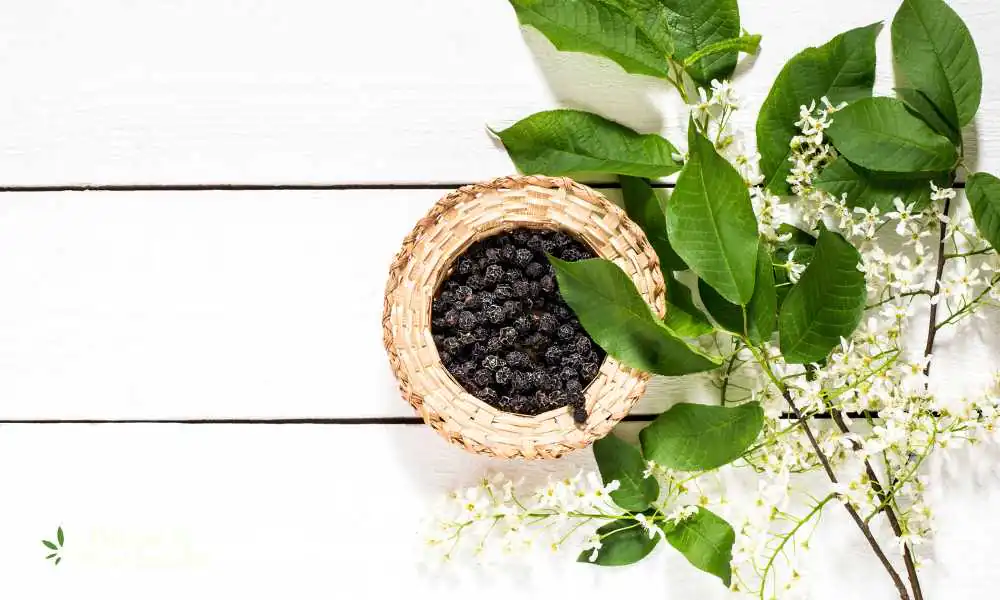
What disinfectant is safe for bird feeders
When it comes to disinfecting bird feeders, you want to use something that is effective at killing pathogens, but also safe for the birds. Here are a few options:
White Distilled Vinegar: White vinegar is a safe and natural disinfectant that can be very effective for cleaning bird feeders. Mix one part vinegar with four parts water for a homemade cleaning solution.
Bleach: A solution of one part bleach to nine parts water can be used to disinfect bird feeders. However, it’s very important to rinse the feeder thoroughly after using bleach to ensure no residue remains that could potentially harm birds. Bleach should only be used as a last resort, for example, during an outbreak of a disease like salmonella among local birds.
Hydrogen Peroxide: Hydrogen peroxide is another safe disinfectant for bird feeders. It can be used undiluted, and the advantage is that it breaks down into water and oxygen, leaving no harmful residues.
Regardless of the disinfectant you choose, make sure to rinse the feeder thoroughly after cleaning, and let it dry completely before refilling. This not only ensures any disinfectant residue is removed, but also that the feeder is dry to prevent the growth of mold and other bacteria.

Cleaning bird feeders without bleach
Cleaning bird feeders is essential for the health of your feathered visitors, and it can be done effectively without using bleach. Here are the steps to do it:
Materials:
- Warm water
- Mild dish soap
- White distilled vinegar
- Scrub brush or old toothbrush
- Rubber gloves
Steps:
- Empty the Feeder: Begin by emptying the bird feeder and discarding any leftover seeds or debris.
- Soak and Scrub: Soak the bird feeder in a basin of warm water mixed with a squirt of mild dish soap. After it has soaked for about 10-15 minutes, use a scrub brush or old toothbrush to clean the feeder thoroughly. Make sure to reach into corners and hidden spots where seeds might get stuck.
- Rinse: Rinse the feeder thoroughly under warm running water to remove all soap residue.
- Disinfect with Vinegar: Once the feeder is clean, you can disinfect it using a solution of one part white distilled vinegar to four parts water. Soak the feeder in this solution for a few minutes, then rinse thoroughly under warm running water.
- Dry Completely: Allow the feeder to air dry fully before refilling it with bird seed. This helps to prevent the growth of mold and other bacteria.
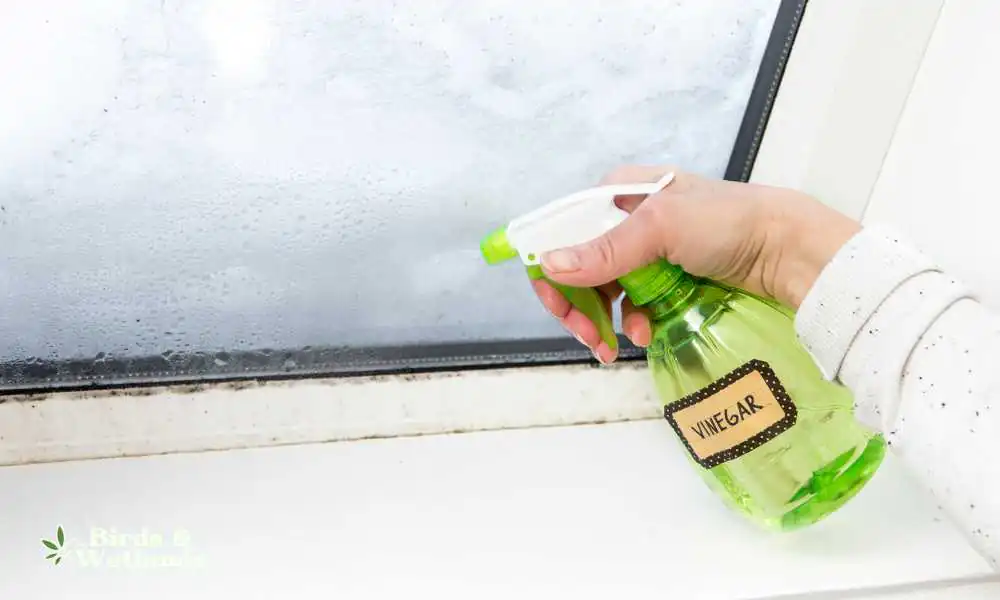
What is the best thing to clean bird feeders with?
The best way to clean bird feeders is using a mild, unscented dish soap or a diluted bleach solution (one part bleach to nine parts water). After emptying the feeder, soak it in the chosen cleaning solution, then use a scrubbing brush to remove any leftover food or droppings. Rinse the feeder thoroughly with warm water to ensure no cleaning residue remains, and let it dry fully before refilling. This process helps prevent the spread of diseases among birds.
Is vinegar good for cleaning bird feeders?
Yes, vinegar is a good choice for cleaning bird feeders. A solution of one part white vinegar to four parts water can effectively clean feeders. After soaking the feeder in the solution, use a scrubbing brush to clean off any remaining debris. Rinse thoroughly with warm water to ensure no vinegar residue remains, as this could deter birds. Allow the feeder to dry completely before refilling. Vinegar is a natural, non-toxic cleaner that can help prevent the spread of diseases among birds.


